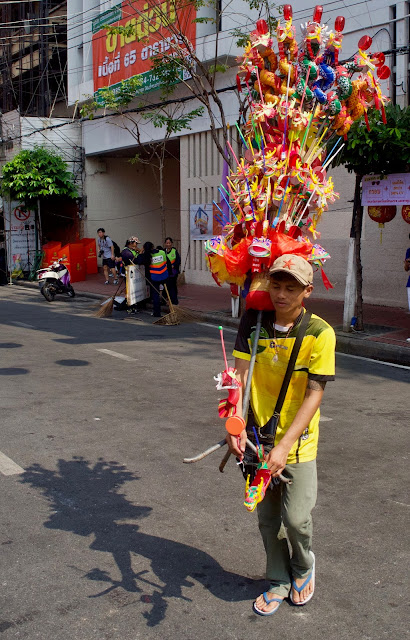 |
| Lunar new year celebration in Bangkok: Welcoming the Year of the Dog |
Bangkok's Chinatown is purportedly the world's largest Chinese community outside of China. Chinese Thais make up a very large portion of the country's population (up to 40%; ethnic Chinese comprise 14%), and their impact socially, economically, culturally, religiously and politically, is enormous. It is estimated that 90% of the country's business investment is by Thai Chinese.
With such a large Chinese population, its celebration of the lunar new year is--not surprisingly--huge. Crowds of people jam the streets and temples of Chinatown for an all day celebration that includes three parades. I like to experience the colors, smells, sounds and sights each year. It is a high energy day of observing Thai-Chinese culture, and interacting with the friendly celebrants.
Following are photos taken sequentially during an eight hour visit to this large 200 year old community on 16 February 2018, the first day of the Year of the Dog.
All photos are © by the author. It is illegal to use any of the images without permission. Use may be granted depending on intent. Please send an email to jsscience@yahoo.com.
 |
| Throngs of people visited temples. This is the popular Chinese temple on Yaowarat Road, near the entry arch and next to Samitivej Hospital. |
 |
| A young boy reaches in vain for the lit "toop" (incense sticks) held by his father at the temple. |
 |
| A first time visitor watches as a merchant hangs colorful streamers to sell at the old Chinatown movie theater. |
 |
| These ladies are part of a large family that had gathered at a home in one of the small back streets of Chinatown. They graciously allowed me to take their portrait. |
 |
| Street photographer Jeremiah Boulware has the tables turned on him as a curious Chinatown resident looks on. |
 |
| A young boy inspects some of the parade finery prior to the procession on Yaowarat Road. |
 |
| A street vendor carries toys along Yaowarat road. |
 |
| I think I photobombed this group, but I tried to snap and quickly get out of the way! Yaowarat Road was closed to vehicular traffic all day and people took advantage to stroll and take photos. |
 |
| A small Chinese Buddhist temple entrance peeks out between the buildings. It is an invitation to discover more about this fascinating community. |
 |
| A quiet space in a tiny alley |
 |
| A typical doorway, festooned with Chinese new year decorations |
 |
| Not far from the bustling sidewalks and cramped alleyways, this man and his dog take time to relax, and why not? it is the Year of the Dog! |
 |
| These two girls were squealing with delight as they played in an empty cardboard box. |
 |
| At the entrance to Wat (Temple) Mai Yai Faeng north of Chareung Kreung Rd, a monk sprinkles holy water on people arriving and those wishing a blessing as they leave. |
 |
| Young monks accept donations that will be used to replace tiles on the temple roof. |
 |
| In a separate building is a wonderful collection of Buddha images. |
 |
| Devotees follow a circular route, striking brass bells with wooden sticks to bring good luck. |
 |
| At Poh Tek Tung, people show devotion by pouring cooking oil into large vessels, which is then collected and used to keep flames burning for lighting incense sticks and candles. |
 |
| Worshippers kneel to pray for good luck and for favorable events. Some, like the woman second from left, shake wooden sticks with numbers that correspond to a written fortune. The person shakes the sticks until one falls out, then goes to a display area that has numbered fortunes. If one does not like the particular fortune they receive, they often try again! |
The traditional Chinese new year festival is alive and thriving in Bangkok. It is one of the biggest events of the year in this city. If you are coming to Bangkok during the winter months, it is well worth your while to experience the Chinese new year celebration. Bangkok Photo Rambles (FB: @photoramblers) is a good way to see Bangkok behind the scenes.













Fantastic images John! The Chinese lunar New Year is a very colorful event indeed! DrJeffBangkok.com
ReplyDelete